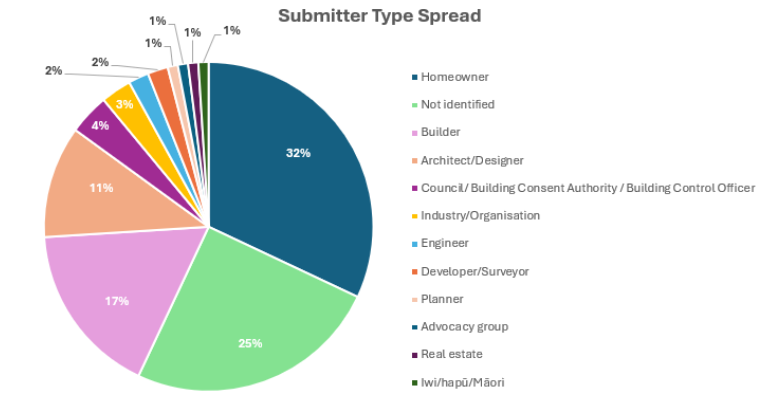Executive summary
On this page I tēnei whārangi
A total of 1,970 submissions were received from a range of submitters on the discussion document. About a third of submissions were received from those who identified as ‘homeowners’. The next greatest number of submissions came from builders, followed by architects and designers. For a full breakdown of submitters, see Figure 1 below:
Figure 1: Graph detailing the submitter spread

Text description for graph - Figure 1: Graph detailing the submitter spread
More information on the public consultation data and the quantitative and qualitative analysis methods is outlined in Appendix A.
Major themes
Below is a list of the most popular themes that came out of the consultation responses.
Part 1: Problem definition, outcomes, and safeguards
Part 2: Proposal under the Building Act 2004
Part 3: Proposal under the Resource Management Act 1991
Part 4: Notification and funding infrastructure
Part 5: Māori land, papakāinga and kaumātua housing
Meaning of terms used
‘Granny flat’ is a term to describe a small, self-contained house. These are also known as secondary or ancillary dwellings, family flats, minor dwellings, self-contained small dwellings and minor residential units.
‘Minor residential unit’ (MRU) is a self-contained residential unit that is ancillary to the principal residential unit and is held in common ownership with the principal residential unit on the same site (National Planning Standards).
This document is designed to give readers a general idea of the number of submitters making similar comments throughout the document. The numerical values of terms used are outlined in the table 1 below.
Table 1: Classification of terms used to indicate number of submitters
| Classification | Definition |
| Few | Fewer than 5% of submitters |
| Some | 6 to 25% of submitters |
| Many | 26 to 50% of submitters |
| Most | More than 50% of submitters |
| All | 100% of submitters on this topic |
For information about the background, methodology, limitations and next steps see Appendix A.

